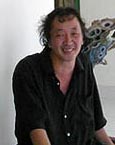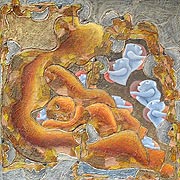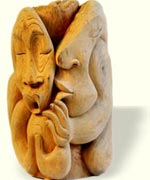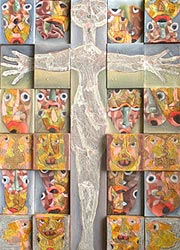|
 |
| Home
> Arts
> Painters
> Antonius Kho |
| |
| Antonius Kho |
| |
 |
| |
 Talking
about Antonius Kho is dealing with the theme of
identity: are we one, or are we split in multiple
facets? Are we masks, and do these masks hide, or
reveal reality? Do we communicate are not? Talking
about Antonius Kho is dealing with the theme of
identity: are we one, or are we split in multiple
facets? Are we masks, and do these masks hide, or
reveal reality? Do we communicate are not?
These themes haunt the artist’s career. We
may look for an explanation in the artist’s
past. A Javanese by his mother, who transmitted
him the longing for oneness inherent to her culture,
Antonius Kho is a “Chinese” by his father,
who stamped him as an alien: “orang Cina”
(Chinese). Speaking
in his strong Javanese dialect, inheriting this
ethnic-cum-cultural duality, Antonius Kho turned
it into a voluntary personality split: he grew adult,
and an artist, by continuously generating and questioning,
though new experience, new layers of identity. |
| |
 The
place, of all places, where he first pursued this
search of the self was Germany: Germany, the fertile
ground of European 19th humanism, and the land of
20th European horrors. The
place, of all places, where he first pursued this
search of the self was Germany: Germany, the fertile
ground of European 19th humanism, and the land of
20th European horrors.
It is the place of contrasts, where, more than anywhere
else, being “alien” has the most daunting
meaning. But Germany opened it self to him. After
studies at the Cologne Institute of the art, he
was soon active as a “German” artist
exhibition internationally.
The artistic mood of the country provided him with
the tools he needed. When he arrived there in 1985,
the genre known in Europe as “informal art”
was flourishing, and artists such as Wols, Fautrier,
Tapies and Dubuffet, were still considered as the
avant-grade. The peculiarity of these “informal”
artist was that they endeavoured to “essentialize”
expressive power by reducing representation to its
“archetypal” core.
 Antonius Kho’s manner evolved from this style,
but with a difference. His paintings, instead of
resting, on amorphous figuration, would mostly consist
of figures, or faces (masks)
structured in the manner of mosaics, that
is split in small, mainly geometric elements and
yet readable in their iconographic totality. The
artist was in these works expressing the tension
between fragmentation and unity that he was experiencing
in his search for identity, as well as the tension
between isolation around the self and communication
with “others”.
Antonius Kho’s manner evolved from this style,
but with a difference. His paintings, instead of
resting, on amorphous figuration, would mostly consist
of figures, or faces (masks)
structured in the manner of mosaics, that
is split in small, mainly geometric elements and
yet readable in their iconographic totality. The
artist was in these works expressing the tension
between fragmentation and unity that he was experiencing
in his search for identity, as well as the tension
between isolation around the self and communication
with “others”. |
| |
 Antonius, however, was somehow was too “awkward”
in this technique, or too shy for his message to
be totally convincing.
Antonius, however, was somehow was too “awkward”
in this technique, or too shy for his message to
be totally convincing.
Now. However, in the recent works, his themes and
treatment are changing for the better.
In some works, the masks and the mosaics are still
present, but it is to convey a message of love,
as in “Bercanda (Joking)”
or simply to show the defeat of pessimism though
the intercession a “Savior”, like in
“Wajah-wajah yang disalibkan” (the
Faces of the Crucified).
Figuration all but disappears, except for “eyes”,
which denote the fusion of Man in the living cosmos.
He seems to tell us that there is after all unity
in Man, and that communication is not an impossible
dream, because the mosaic of life and that of one’s
identity always ultimately melt into cosmic oneness.
So this most “European” Indonesian artist
is now rediscovering his real mother: Java; and
his quest of identity leading him to a spiritual
rediscovery. Antonius Kho has finally found his
path toward maturity. |
| |
|
| |
WINA - Widuri
& Sena Gallery
Jl. Raya Sanggingan, Ubud - Bali
P.O.Box 155. Ubud Bali
Tel : (62 361) 978008
Mobile : (62 81) 8496 247 - (62 81) 338 728 483
Email : info@antoniuskho.com
Website : www.antoniuskho.com |
| |
|
|
|
|
